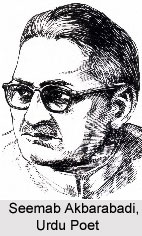 Seemab Akbarabadi, born on 5th June 1882, was a celebrated poet in Urdu language that belonged to the Daagh School. He also hailed from Agra where his family had lived for nearly three hundred years.
Seemab Akbarabadi, born on 5th June 1882, was a celebrated poet in Urdu language that belonged to the Daagh School. He also hailed from Agra where his family had lived for nearly three hundred years.
Early Life of Seemab Akbarabadi
Seemab Akbarabadi was the descendents of Abu Bakr as-Siddiq who was the first of Caliph of Islam, and was born in Agra, as the eldest son of Mohammad Hussain Siddiqui, who was himself an Urdu poet, author of several books, a disciple of Hakim Amiruldin Attaar Akbarabadi, and an employee of the Times of India Press at Ajmer
Seemab Akbarabadi had of course said that his forefather had migrated from Bukhara which was sometime during the reign of Mughal Emperor Jehangir and made Agra his home, however, according to Mohan Lal - his great-grandfather had migrated from Bokhara during Aurangzeb`s reign. Seemab learnt the Persian language from Jamaluddin Sarhadi and Rashid Ahmed Ganguli.
In 1897 after his father died, Seemab was forced to give up his studies and seek livelihood first in Agra and then in Kanpur before joining the railways service at Ajmer, from which he resigned in 1922 and returned to Agra. In the year 1923 he also founded the publishing imprint, Qasr-ul-adab. He had four sons and two daughters and the youngest son, Mazhar Siddiqui, continued his work in Karachi and published many of his father`s manuscripts.
Literary Life of Seemab Akbarabadi
In the year 1898, Seemab started ghazal writing and after few years in 1898 became the disciple of Nawab Mirza Khan Daagh Dehlawi (to whom he was personally introduced by Munshi Nazar Hussain Sakhaa Dehlawi at the Kanpur Railway Station).
After setting up "Qasr-ul-adab" in 1923 with Saghar Nizami as its editor, he started publishing the Monthly "Paimana". In 1929, he started the Weekly "Taj" and in 1930 the Monthly "Shair". The publication of "Paimana" ceased in 1932 when Saghar Nizami separated from Seemab and moved to Meerut. "Shair" continued to be published long after Seemab`s death, managed and edited (since 1935) by his son, Aijaz Siddiqi, and "Wahi-e-manzoom" published by his son Mazhar Siddiqui from Karachi was graced ith a Hijra Award on 27 Ramzan by the President of Pakistan, General Zia-Ul-Haq.
Beginning with the publication of his first collection of poems," Naistaan" in 1923, Akbarabadi published seventy-five books throughout his life. These included twenty-two books of poetry, not including "Loh-e-mahfooz" (1979), "Wahi-e-manzoom" (1981) and "Saaz-e-hijaz" (1982), all published long after his death. He is best known for his ghazals particularly by those sung by Kundan Lal Saigal. He also wrote short stories, novels, dramas, biographies and critical appraisals and was acknowledged as a master of Urdu, Persian and Arabic language and grammar.
Works of Seemab Akbarabadi Include:
Naistan (1923)
Ilhaam-e-manzoom (1928)
Kaar-e-imroz (1934)
Kaleem-e-ajam (1936)
Dastur-ul-islah (1940)
Saaz-o-aahang (1941)
Krishna Gita (1942)
Aalam Aashool (1943)
Sadrah almantaha (1946)
Sher-e-inqlaab (1947)
Loh-e-mahfooz (1979)
Wahi-e-manzoom (1981)



















